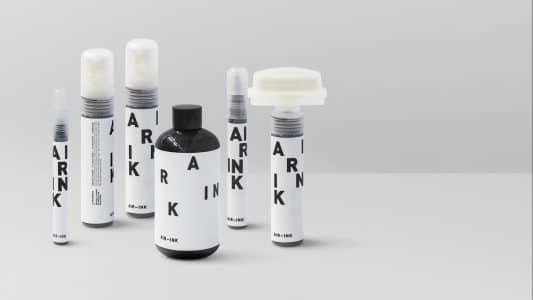Air-Ink: the start-up turning air pollution into ink - Dispatch Weekly
March 14, 2017 - Reading time: 6 minutes

In 1952, the city of London suffered from three days of would be called “The Great Smog”. A phenomenon where high concentration of pollutants in the atmosphere lead to a creation of thick fog and smoke, blocking vision and polluting lungs when inhaled.
It was one of the worst environmental events derived from direct human pollution seen in London, killing 8000 people and leaving many more hospitalized. Smog was a direct cause of air pollution and raised concerns over the effect factories and coal burning was having on the environment.
Fast forward to 2017, and smog is seen daily in some of the biggest cities around the world, including India and China. Breathing in toxins and allergens daily can have severe effects on health.
According to the World Health Organization:
“Every year more than half a million people are estimated to die prematurely because of air pollution.”
Although organisations and governments worldwide promise to put correct efforts into action, air pollution continues to be one of the most harmful environmental effects to human health, and nature.
A small start-up by Graviky Labs has taken it upon themselves to find a creative solution to the problem, that may help improve quality of life for many in heavily polluted cities.

Air Pollution released by factories
AIR-INK
Meet AIR-INK. Developed as an experiment in the MIT Media Lab in Cambridge, Massachusetts, this Indian start-up has discovered a way to turn air pollution into ink. Only four years after their establishment, the company has created a revolutionising process that achieves major milestones in environmental efforts, aiming to reduce air pollution.
Using it’s proprietary device, Kaalink, to capture soot released into the air, the start-up has found a way to turn outgoing pollutant emissions from vehicles, into ink.
It does so by retrofitting their Kaalink device to the exhaust pipe of vehicles or generators, allowing it to capture pollutants directly at their moment of emissions.

Source: Graviky – Air-Ink Art
Once soot is collected, a deep black powdery substance consisting largely of amorphous carbon, undergoes various processes to remove the heavy metals and carcinogens found in the substance. Filtering them out, the company achieves a purified carbon rich pigment, which is used to make different types of inks and paints. It is then used to create a variety of products, from a 2mm round tip pen, to a chisel tip marker, to screen printing ink.
Just 45 minutes worth of vehicular emissions captured by Kaalink is able to produce one fluid ounce of ink. This is enough to fill one of the pens offered through it’s Kickstarter campaign.
Using as little as 30ml of AIR-INK could help negate 45 minutes of car pollution.
This potential solution to air pollution is the first step into improving the quality of life and health of populations in major cities everywhere. Replacing as little as 15% of the current market, ink with AIR-INK would be enough to see a significant improvement in air quality.
The incredibly creative company aims to use their funds from the Kickstarter campaign to refine their Kaalink device and help scale-up production. They aim to make their product accessible to a wider market and increase the positive results to a worldwide effect.
Exciting technology tackling pollution
But Gravikly Labs isn’t the only creative solution developed in the recent years to pollution. Incredibly enough, efforts into reducing pollution have made it’s way into fashion.
Developed as part of a wearable technology competition, University of California engineering professors Mihri Ozkan and Cengiz Ozkan developed a “sponge bikini”, which can absorb pollution from the sea.

Source: Bagnet – Sponge Bikini
The project, created from an idea to turn swimming into an “eco-friendly activity”, uses a porous material called “Sponge” to absorb all oil-based contaminants, and repel water. It’s network of nano carbons originating from sugar are able to absorb up to 25 times its own weight.
Once absorbed, the substances can then be released from the material by heating it to temperatures of 1,000 degrees Celsius, after which it can be filtered of contaminants and reshaped for reuse. This powerful tool for water decontamination promises to be the beginning of a new era of eco-friendly fashion, goes beyond environmental-compliance to environmental-impact reduction.
With the growing concern of human activity on the environment, a number of start-ups have opened around the world to tackle the issue. It seems we may finally be making a change into an eco-friendly society, and it is incredibly exciting.
Know any other start-ups making their mark in pollution reduction? Let us know by commenting below.

DW Staff
David Lintott is the Editor-in-Chief, leading our team of talented freelance journalists. He specializes in covering culture, sport, and society. Originally from the decaying seaside town of Eastbourne, he attributes his insightful world-weariness to his roots in this unique setting.




